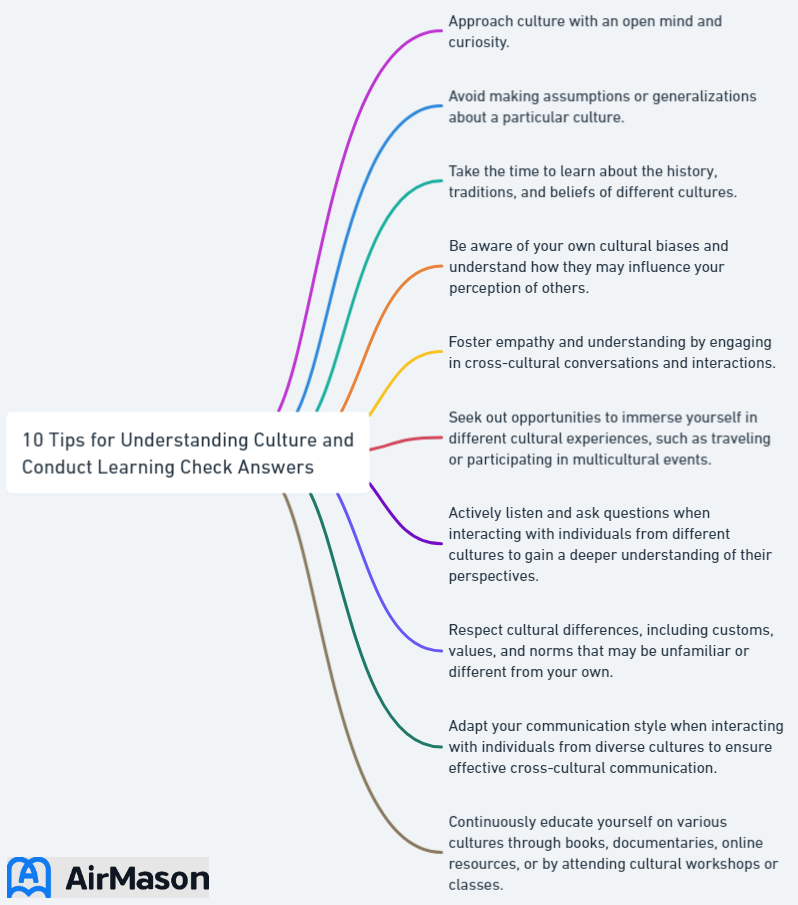
In today’s fast-paced and competitive business world, understanding the importance of culture and conduct in the workplace is more crucial than ever. A healthy work environment can lead to increased employee engagement, enhanced productivity, and overall success. But how can we effectively learn and implement these vital aspects of company life? In this blog post, we’ll explore a comprehensive approach to understanding culture and conduct through “culture and conduct learning check answers”, providing you with valuable insights and best practices to create a thriving workplace.
Key Takeaways
- Understanding culture and conduct is essential for creating a productive work environment.
- Learning checks are an invaluable tool for assessing employee understanding of company values.
- Regularly assessing and reinforcing organizational values helps to create a positive work environment, leading to increased engagement, productivity, and success.
Understanding the Importance of Culture and Conduct
Understanding the role of culture and conduct in the workplace can significantly boost employee engagement, productivity, and overall success. Creating a work environment that supports collaboration, shared goals, and a strong sense of belonging is possible through a deep understanding of the relationship between a company’s culture and its employees’ behavior.
A healthy culture not only benefits the employees and the organization but also contributes to a company’s competitive advantage and long-term growth.

Defining Organizational Culture
Organizational culture refers to the shared values, beliefs, and practices within a company. It is the foundation upon which an organization’s culture is built and plays a significant role in shaping employee behavior and attitudes. Cultural symbols, such as company logos or office merchandise, can help employees gain insight into organizational culture and reinforce a sense of identity and motivation.
A deep understanding of your organization’s culture enables better alignment of your actions and decisions with the company’s values and objectives, thus fostering a successful and cohesive workplace.
An Organization’s Culture
An organization’s culture is the bedrock upon which its values, norms, and behaviors are built. It encompasses the collective attitudes and beliefs shared by its members, shaping how they interact and collaborate within the workplace. This dynamic force influences everything from decision-making processes to the way employees approach challenges and opportunities. A healthy organizational culture fosters a sense of belonging and purpose among employees, driving them to strive for common goals. Conversely, a toxic culture can lead to disengagement, high turnover rates, and hindered productivity. Recognizing the pivotal role of an organization’s culture is essential for leaders, as it serves as the compass guiding the company towards success or stagnation.
The Role of Conduct in the Workplace
Conduct, the behavior and actions of employees that align with the company’s culture, plays a vital role in maintaining a healthy work environment and ensuring adherence to the company’s values and ethical standards. An understanding of the expected conduct in their workplace enables employees to contribute to a positive work culture and collaborate effectively with their colleagues.
This, in turn, can lead to increased job satisfaction, improved relationships, and a sense of being supported and encouraged to succeed, as it provides an answer to employees’ needs.
The Link Between Culture and Conduct
A strong link between culture and conduct ensures a positive work environment and effective collaboration. When employees understand and adhere to their company’s culture, they are more likely to exhibit the desired behaviors and contribute to the overall success of the organization. This can be further reinforced through team-building activities, which promote a sense of purpose and responsibility, as well as pride and camaraderie among employees.
Fostering a strong connection between culture and conduct enables companies to create a harmonious and productive workplace where everyone collaboratively works towards the same goals.
Identifying Key Components of a Culture and Conduct Learning Check

A culture and conduct learning check is a valuable tool that can help organizations assess employee understanding and alignment with company values, in addition to identifying areas for improvement. By focusing on key components such as values and ethics, communication style, and teamwork and collaboration, a learning check can provide insights into the overall cultural health of the organization.
The upcoming sections will delve into a detailed exploration of these components and their importance in shaping a thriving workplace.
Most Experts Agree that Culture Includes the Following Key Factors
When delving into the multifaceted concept of culture, it becomes evident that most experts agree on the presence of certain pivotal elements. Language stands as the cornerstone, serving not only as a means of communication but also as a repository of shared history and values. Social norms and customs, another crucial factor, dictate appropriate behavior within a given community, shaping interactions and relationships. Belief systems and religious practices form yet another vital facet of culture, influencing worldviews, moral codes, and rituals. Additionally, material expressions, such as art, architecture, and artifacts, offer tangible manifestations of cultural identity and creativity. Lastly, the ever-evolving influence of technology has become an integral part of contemporary culture, revolutionizing how societies interact, share information, and express themselves. In sum, these key factors collectively contribute to the rich tapestry that defines and distinguishes one culture from another.
Values and Ethics
Values and ethics are the foundation of a company’s culture and conduct. They outline the beliefs, principles, and behavioral norms that guide employees’ actions and decisions. Understanding and adherence to the company values enable employees to contribute to a healthy and unified work environment, thus promoting trust, integrity, and accountability.
Furthermore, a culture that is in line with the company’s values can augment employee engagement, productivity, and overall organizational success.
Communication Style
Communication style plays a significant role in fostering a positive work environment and promoting collaboration. Successful collaboration relies heavily on effective communication among team members, which facilitates the sharing of ideas, perspectives, and insights. Creating a trusting and supportive atmosphere, sharing goals and feedback, and reducing workplace stress can be achieved by understanding and adapting to different communication styles, thereby enhancing collaboration and improving team dynamics.
Teamwork and Collaboration
Achieving company goals and maintaining a healthy organizational culture hinges on effective teamwork and collaboration. Working together enables employees to leverage their collective strengths and skills for effective problem-solving and task completion.
To reinforce teamwork and collaboration, consider incorporating the following strategies:
- Conduct team debriefings to reflect on successes and areas for improvement.
- Promote collaboration among team members by encouraging open communication and sharing of ideas.
- Establish a culture of accountability, where team members take ownership of their responsibilities and hold each other accountable for their actions.
By implementing these strategies, you can foster a strong sense of teamwork and collaboration within your organization.
Moreover, recognizing and rewarding collaborative efforts can further strengthen the company’s culture, fostering a sense of unity and cooperation among employees.
Analyzing Company Culture Through Learning Checks

Analyzing company culture through learning checks helps identify areas for improvement and reinforce organizational values. Focusing on specific aspects of the company culture, like its mission statement, core values, or ethical guidelines, allows organizations to gauge the level of cultural understanding and pinpoint areas needing improvement or reinforcement.
The upcoming sections will delve into how learning checks can facilitate the assessment of employee understanding, identification of cultural gaps, and reinforcement of organizational values.
Assessing Employee Understanding
The assessment of employee understanding of company culture and conduct forms a critical component of learning checks. This can be achieved through various methods, such as employee surveys, focus groups, and performance appraisals. Evaluating employees’ comprehension of the company’s values, norms, and behaviors allows organizations to identify areas where the company culture is well-understood and areas in need of further education or clarification.
This can help organizations assess the efficacy of their culture training programs and make informed decisions on how to enhance employee comprehension and alignment with the desired culture.
Identifying Cultural Gaps
The identification of cultural gaps within an organization is key to fostering a healthy and unified work environment. Conducting learning checks that zoom in on specific aspects of the company culture enables organizations to spot potential gaps in employee understanding and tackle them appropriately. This can help create a more inclusive and cohesive culture, where employees from different backgrounds and perspectives can work together effectively.
Addressing cultural gaps can also lead to improved communication, increased trust, and enhanced collaboration within the organization.
Reinforcing Organizational Values
Learning checks serve as a potent tool for reinforcing organizational values and bolstering company culture. Designing learning checks around the company’s core values helps employers ensure that employees internalize these values and incorporate them into their daily work. Regularly assessing and reinforcing these values can help create a strong foundation for a positive work environment, ultimately leading to increased employee engagement, productivity, and overall success.
Examples of Positive Impact at Work
Examples of positive impact at work can be seen in various aspects of professional life. One such instance is when a team successfully implements an innovative solution, leading to increased efficiency and productivity. This not only benefits the organization but also fosters a sense of accomplishment and motivation among team members. Additionally, mentoring programs that nurture the skills and talents of junior employees can have a profound positive impact on their career growth and overall job satisfaction. Furthermore, corporate social responsibility initiatives, such as volunteering or supporting local communities, not only reflect positively on a company’s reputation but also instill a sense of pride and purpose in employees. Another noteworthy example is when leaders actively listen to their team members’ feedback and implement constructive changes, creating a more inclusive and collaborative work environment. Lastly, recognizing and celebrating individual and team achievements through awards and acknowledgments can boost morale and create a culture of appreciation, which in turn leads to a more engaged and motivated workforce.
Implementing Effective Culture and Conduct Learning Checks

The implementation of effective culture and conduct learning checks requires the setting of clear objectives, the selection of an appropriate format, and the encouragement of employee participation. These factors are crucial for ensuring that the learning check is focused, engaging, and effective in promoting employee understanding and alignment with the company’s culture.
The upcoming sections will delve into a detailed discussion of these aspects and offer strategies for the successful implementation of learning checks.
Setting Clear Objectives
The focus and effectiveness of the learning check hinge on the setting of clear objectives. These objectives should be:
- Specific
- Measurable
- Achievable
- Relevant
- Time-bound (SMART)
By establishing clear objectives, learning checks can be designed to address specific areas of the company culture, such as values, communication styles, or teamwork. This not only ensures that the learning check is targeted and efficient but also allows employees to better understand their role and responsibilities within the organization.
Choosing the Right Format
Selecting an appropriate format for the learning check is key to maximizing its effectiveness and keeping employees engaged throughout the process. Possible formats include quizzes, surveys, or group discussions, each with its own advantages and challenges. The optimal format should be aligned with the content and desired outcomes of the learning check, taking into consideration factors such as employee preferences, company culture, and available resources.
By selecting the most suitable format, organizations can ensure that their learning checks are both engaging and effective.
Encouraging Employee Participation
The success of any learning check depends heavily on encouraging employee participation. Creating a supportive and open environment enables employers to make employees feel at ease sharing their thoughts and ideas, thus contributing to a more effective learning experience. This can be achieved by promoting open dialogue, providing opportunities for collaboration, and offering constructive feedback.
Actively engaging employees in the learning process allows organizations to cultivate a culture of growth and development, encouraging continual improvement in understanding and alignment with company values.
Evaluating and Improving Culture and Conduct Learning Check Answers

The process of evaluating and improving culture and conduct learning check responses enables organizations to spot trends, tackle areas for improvement, and acknowledge successes. By reviewing learning check results and identifying patterns, organizations can gain valuable insights into employee understanding and alignment with company culture.
The subsequent sections will delve into strategies for reviewing results, tackling areas for improvement, and celebrating successes to fortify company culture.
Reviewing Results and Identifying Trends
Understanding employee alignment with company culture necessitates reviewing results and identifying trends in learning check responses. By analyzing the patterns and trends in learning check responses, organizations can identify gaps in knowledge or misconceptions that may impact the overall company culture.
This information can then be used to inform targeted training and support, ensuring that employees have a comprehensive understanding of the company’s values and expectations.
Addressing Areas for Improvement
Tackling areas for improvement forms an integral part of the evaluation and improvement of culture and conduct learning check responses. By providing targeted training and support, organizations can help employees develop the skills and knowledge needed to better align with company values and expectations. This not only contributes to a more cohesive and unified work environment but also fosters a culture of continuous learning and development, where employees are encouraged to:
- Grow and improve
- Embrace new challenges
- Seek feedback and learn from it
- Take ownership of their own development
- Collaborate and share knowledge with others
Celebrating Successes and Strengthening Culture
An integral part of evaluating and improving learning check responses involves celebrating successes and fortifying company culture. By recognizing and rewarding employees who demonstrate strong cultural alignment, organizations can foster a sense of camaraderie and unity among their workforce. This not only boosts employee morale and engagement but also helps to reinforce the company’s values and expectations, ultimately leading to a more positive and productive work environment.
Common Challenges and Solutions in Culture and Conduct Learning Checks

Implementing culture and conduct learning checks can present various challenges, such as resistance to change, time constraints, and ensuring consistency and relevance.
The upcoming sections will delve into a discussion of these common challenges and their solutions, offering guidance on:
- Overcoming obstacles
- Crafting effective learning checks
- Fostering employee growth
- Aligning with company culture
Resistance to Change
Resistance to change can be a significant challenge when implementing culture and conduct learning checks. This issue can be addressed by organizations through the following steps:
- Communicate the benefits of the learning check to employees.
- Involve employees in the process and seek their input.
- Help employees recognize the value in the change and be more open to embracing it.
- Emphasize the advantages of the learning check, such as increased productivity, improved collaboration, and enhanced employee engagement.
By following these steps, organizations can overcome resistance to change and successfully implement culture and conduct learning checks.
Time Constraints
Managing time constraints during culture and conduct learning checks can be a challenge, but the following tips can help optimize the learning experience while working within the given time constraints:
- Set clear time limits to ensure participants stay on track.
- Prioritize essential topics to make the most efficient use of time.
- Incorporate interactive exercises and discussions to keep participants engaged.
- Present concise and targeted content, avoiding unnecessary details.
- Break down the learning check into smaller segments to avoid feeling overwhelmed.
Ensuring Consistency and Relevance
Ensuring consistency and relevance in culture and conduct learning checks is vital for their success. To maintain consistency, organizations should regularly review and update learning check content to ensure it remains relevant and aligned with company goals and values. By doing so, organizations can create engaging and effective learning checks that promote employee growth and understanding of company culture.
Case Studies: Successful Culture and Conduct Learning Checks

Case studies of successful culture and conduct learning checks can provide valuable insights and best practices for organizations looking to implement their own learning checks. In the following sections, we’ll explore three examples of companies that have successfully used learning checks to improve their culture and conduct, reinforcing core values, fostering collaboration and teamwork, and improving communication and transparency.
Company A: Reinforcing Core Values
Company A successfully reinforced its core values through targeted training and employee recognition. Company A ensured that its core values remained a fundamental part of the organization by regularly communicating values to employees and incorporating them into training and development programs.
The learning checks helped employees internalize these values and apply them in their daily work, ultimately contributing to a successful and cohesive workplace.
Company B: Fostering Collaboration and Teamwork
Company B focused on fostering collaboration and teamwork in their company’s business through:
- Group activities
- Open communication
- Team-building exercises
- Collaborative projects
- Activities designed to cultivate communication and collaboration among team members
This created an atmosphere where employees felt respected and heard.
This approach not only enhanced collaboration and teamwork but also contributed to a positive and unified work environment.
Company C: Improving Communication and Transparency
Company C improved communication and transparency by implementing the following strategies:
- Regular feedback sessions
- Promoting open dialogue
- Creating a collaborative atmosphere where employees felt valued and heard
- Fostering an open communication policy to encourage employees to express their feedback and ideas
These efforts resulted in improved communication and a more transparent work environment.
This approach not only improved communication and transparency within the company but also contributed to a more positive and inclusive work culture.
Tips for Preparing for Culture and Conduct Learning Checks
Preparing for culture and conduct learning checks is an essential part of ensuring their success and maximizing their impact on employee understanding and alignment with company culture. The subsequent sections will delve into tips for preparing for learning checks, including understanding company values, practicing self-reflection, and seeking feedback from colleagues and supervisors.
Understanding Company Values

A key aspect of preparing for culture and conduct learning checks involves understanding company values. By familiarizing yourself with your organization’s core values, you can better align your actions and decisions with the company’s expectations and contribute to a more cohesive and unified work environment.
This not only helps ensure a successful learning check experience but also fosters a positive work culture where employees feel supported and encouraged to grow.
Practicing Self-Reflection
Practicing self-reflection, which enables individuals to identify areas for improvement and personal growth, forms an integral part of preparing for culture and conduct learning checks. By reflecting on your own actions, thoughts, and behaviors, you can gain a deeper understanding of your strengths and weaknesses, and make informed decisions about how to improve your alignment with company values and expectations.
Regular self-reflection can also help foster a culture of continuous learning and development, where employees are encouraged to grow and improve both personally and professionally.
Summary
Understanding culture and conduct in the workplace is critical for fostering employee engagement, productivity, and overall success. In this blog post, we’ve explored the importance of culture and conduct learning checks, as well as best practices for implementing, evaluating, and improving these assessments. By incorporating these strategies and tips into your organization, you can create a positive work environment that encourages collaboration, shared values, and a strong sense of unity among employees. So, why not take the first step toward creating a thriving workplace by implementing culture and conduct learning checks in your organization today?
Frequently Asked Questions
How do employees learn culture in an organization?
Employees learn culture through direct observation of program offerings, stories, material symbols and language, which best represents the organization’s values and beliefs.
What are the main components of a culture and conduct learning check?
The main components of a culture and conduct learning check are values and ethics, communication style, and teamwork and collaboration.
How can learning checks help reinforce organizational values?
Learning checks can reinforce organizational values by incorporating them into training programs, ensuring employees understand and apply them in their work. This helps to ensure that values are embedded in the organizational culture.
What are some common challenges faced when implementing culture and conduct learning checks?
Implementing culture and conduct learning checks can be challenging due to resistance to change, time constraints, and the need for consistency and relevance.
How can organizations effectively manage time constraints during learning checks?
Organizations can effectively manage time constraints during learning checks by prioritizing essential topics, setting clear time limits, and breaking the assessment into smaller segments.